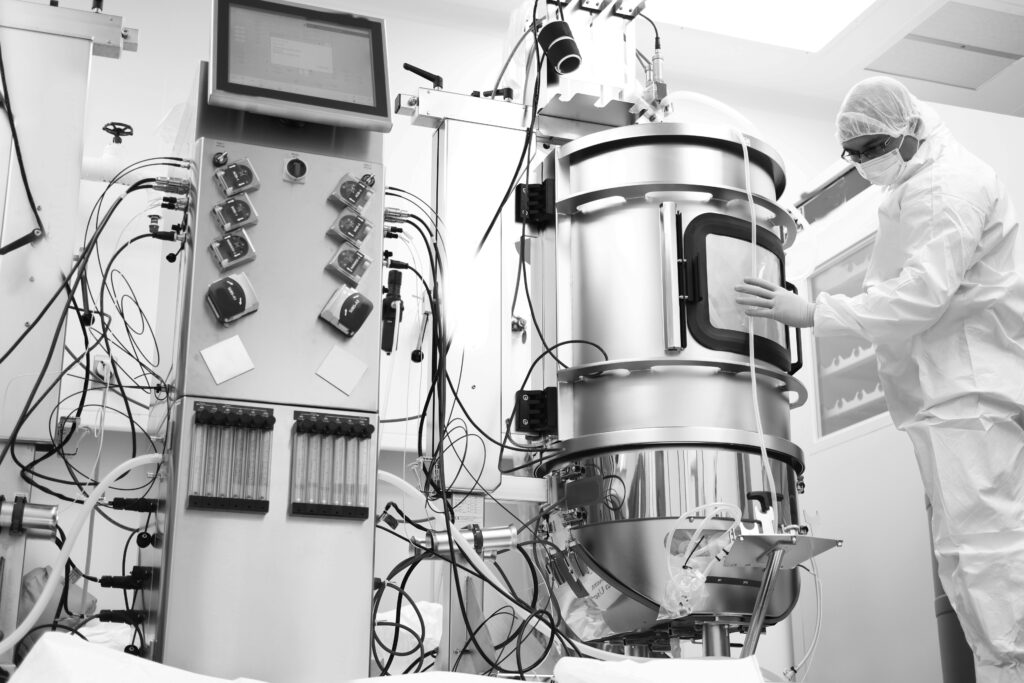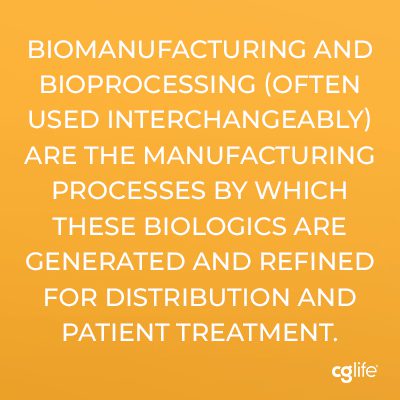

17 Key Biomanufacturing & Bioprocessing Terms to Know
If you work in or around the biopharmaceutical industry, there’s no escaping the need to write about biomanufacturing or bioprocessing. Even if you don’t normally specialize in biopharma, you may find yourself needing to converse about it more frequently these days. The biopharma industry has been in the mainstream spotlight more than ever before in the past few years, as new kinds of treatments – such as immunotherapies – have reached the market. Obviously, the COVID-19 pandemic itself created an astronomical demand for vaccines and even biologic therapies, like COVID-19 monoclonal antibodies.
Like many other fields at the intersection of science and technology, biomanufacturing comes with what can feel like an overwhelming number of specialized terms and concepts. Sometimes different people within the industry will even use the same term in different ways!
Here at CG Life, we’ve had the privilege of working with many biopharma and biomanufacturing experts across multiple areas of the biologics ecosystem. In this blog, we’ll break down some of the key terms and concepts you’ll need to know to write about bioprocessing.
Biologics, Biomanufacturing, Bioprocessing – Which Words to Use and When


Biologics, also known as biopharmaceuticals or biologic medical products, are drugs made by or extracted from living organisms. These can include monoclonal antibodies, enzymes, nucleic acids, vaccines, CAR T-cell therapies, gene therapies, and much more!
In turn, biomanufacturing and bioprocessing (often used interchangeably) are the manufacturing processes by which these biologics are generated and refined for distribution and patient treatment. A bioprocess can refer to the start-to-finish production of a biologic, or to any one of the individual steps involved. Since these are some of the most basic terms thrown around in the industry, they’ll soon become like the air you breathe. Okay, maybe not quite, but the point stands!
Bioreactors 101
“Bioreactor” is one of those words that can conjure up very different images in different industries. In agriculture, a bioreactor is a trench filled with wood chips at the edge of a field, the purpose of which is to remove nitrates from drainage water. In bioprocessing, however, bioreactors are essentially large, closed vessels that are used to cultivate cells used to produce biologics. These bioreactors maintain consistent temperatures and also make room for media and gas exchange needed to grow cells and produce the desired product.
Traditional large-scale bioreactors are stainless-steel behemoths known as fed-batch bioreactors. Manufacturers put in specific amounts of cells and media, let the process run for a set number of days, and then remove everything from the tank, including the product they’ll be harvesting. Then they repeat these steps with new cells, media, and eventual product – hence the “batch” in the name.
In contrast, perfusion bioreactors have filtration technology that lets them remove old media and add new media without removing live cells, which in many cases accelerates the growth and production process. These bioreactors also allow manufacturers to harvest product continually, although some still choose to create specified batches for regulatory or other reasons.
Single-use bioreactors – also called disposable bioreactors – use disposable polymer bags in place of stainless-steel tanks, eliminating cleaning steps for more flexibility. These can be used in fed-batch or perfusion processes depending on the system.
Before we move on, it’s also important to understand that a single bioprocess might involve numerous bioreactors. The N-stage bioreactor is where the biologic product is actually harvested from the cells. Before the cells get to this stage, though, they often go through a chain of smaller bioreactors called a seed train, where the cell population serially expands from a small initial culture. Often, biomanufacturers are also focused on the N-1 bioreactor, or the bioreactor just before the N-stage, because it’s critical for reaching cell counts high enough to complete production runs.
Just Around the Riverbend? – Upstream vs. Downstream Processes
Essentially, every bioprocess has two parts: production and purification. The upstream process is where the product is generated, along with everything that leads up to that generation. This includes cell line development, cell growth and expansion, and the expression of the desired product in the production bioreactor. Optimizing upstream processes means making the largest possible quantities of high-quality product in the shortest amount of time.
The downstream process is where the resulting product is purified and processed, usually via different chromatography and viral filtration systems. The focus on the downstream side is minimizing product loss while maximizing speed and purity.
Are “Continuous” and “Connected” Bioprocesses Interchangeable?
No…but also yes? Oftentimes, the terms are frequently treated that way, even by industry insiders. It’s a good idea to clarify with someone what exactly they’re talking about before you get too far into a conversation.


A connected process is exactly what it sounds like – all of the equipment is connected and materials flow directly between bioreactors and other parts of the system. However, connected processes often include surge and holding tanks that can differentiate “batches” and adjust for differences in flow rates at different points in the system.
A truly continuous process is also by necessity a connected process but doesn’t have any of those holding or surge tanks. In these perfusion processes, product flows straight through from start to finish. This strategy can be very efficient but requires a lot of fine-tuning of flow rates and other variables. Of course, truly continuous processes require significant oversight, AI, and monitoring in order to be effective. But, when done right, it means you have an almost perpetual supply of a biologic. That’s pretty neat, right?
What is Process Intensification?
Process intensification, sometimes abbreviated PI, is a broad term that can refer to any measures taken to make a bioprocess more efficient and profitable. For example, some manufacturers might “intensify” their process to lower operating costs, while others might want to increase volumetric productivity in order to meet high market demand for their drug.
In many cases, process intensification involves technology upgrades. These can include swapping out types of bioreactors, altering chromatography systems on the downstream side, switching to single-use technologies, or introducing automation. Speaking of which…
Bioprocessing 4.0? Why not 3.5 or 2.8?


Many scientists and economic analysts expect the next big thing in manufacturing to be a dramatic rise in automation. Some commentators refer to this new era of automation as the Fourth Industrial Revolution or “Industry 4.0,” so the biomanufacturing-specific term is “Bioprocessing 4.0.” Due in part to its tightly regulated and highly complex nature, the biopharma industry has lagged behind many others when it comes to implementing smart manufacturing. However, companies are slowly embracing advancements like digital monitoring systems and simulation-based process analysis tools. Automation is definitely something to bring up in any discussion about the future growth of a biopharma company.
Final Remarks
These are just a few of the bioprocessing terms and concepts you’ll likely encounter, but we hope this blog will provide you with a basic foundation that can help you navigate more specialized resources and gain more understanding of this incredible field. To dig deeper into an expanding corner of the biopharma and biologics industry, check out our blog about biosimilars.
Otherwise, if you’re looking for expert help making your own bioprocessing content, give us a holler!
